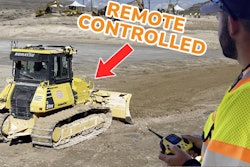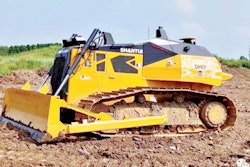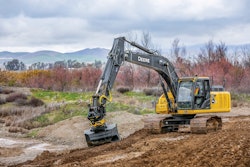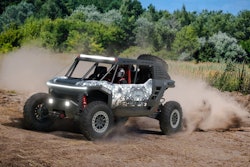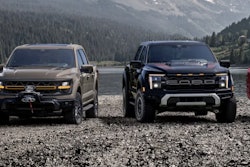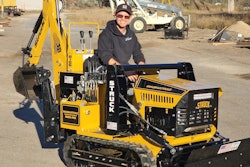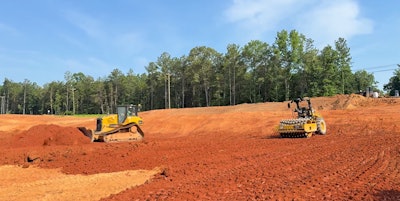
Dick Zhang says the two biggest misconceptions about autonomous construction equipment are that it takes months or years to get started with it and it costs hundreds of thousands of dollars.
He says his company, Bluelight Machines, is here to prove it can be done for under $50,000 and in a matter of an hour and a half, from installation to field deployment.
The retrofit AI-powered supervised autonomy control system allows one person to monitor and manage multiple machines simultaneously, all from a single mobile device. It debuted in 2023 for soil compactors and has since expanded to articulated dump trucks, with plans to connect to other machines soon.
Bluelight is already being used on dozens of jobsites across the country and recently hit a milestone of over 500 million square feet rolled autonomously, the company says.
Installation and Training
The system comes in a box smaller than a suitcase and includes two GPS receivers, two cameras, a “brain” box with a plug-and-play harness, joystick wiring and a modified steering wheel. Everything is mounted to the machine with magnets – no drilling or welding required – and can be removed at any time. The machines can also still be operated manually with the kit installed. The same kit can be used for rollers and articulated trucks.
It is compatible with internet-based base stations like Trimble’s IBSS, eliminating the need for additional hardware. The only requirement is that the site must have 4G or Starlink.
“You just plop everything in place, plug in a few wires and that’s it. That’s the magic of this system,” says Zhang. “We made it easy to use because the pressure for production is just so high.”
The training process takes even less time, with Zhang claiming he can get a recent high school graduate or a 60-year-old dozer operator up and running in “probably three minutes.”
“You put the [phone or tablet] in your hands, you start drawing circles on the screen, you hit “Go,” and it starts rolling,” he explains. “And then, it’s probably like a week to get comfortable with all the finer details of everything.”
AI-Powered Safety Features
Bluelight leverages AI to enhance both safety and performance on the jobsite, using its more than 10,000 autonomous miles logged for continuous learning. Each additional machine connected helps the entire autonomous fleet improve and adapt to site conditions.
“You cannot build a very robust AI on some test site,” says Zhang.
“We have literally hundreds of units out there with thousands of hours of manual and autonomous operation, collecting hundreds of thousands of pictures from all over the country. We can use that to train the AI, so that when we install the system on a roller, poof, it’s like magic – it just knows what a dozer is. That flywheel has been extremely powerful."
Zhang adds that zero injuries have been reported on any sites using the system.
Compatibility and Data Sharing
Bluelight is currently compatible with 2015 or newer Cat CS54B, CS56B, CS11, CS12 compactors and 2018 or newer Cat 730, 740, 745 articulated dump trucks. It is available through select Cat, Sitech and Topcon dealerships.
Zhang notes that while Bluelight started with Caterpillar connectivity due to it being the brand most requested by initial direct customers, compatibility with additional manufacturers will be announced soon. Data from the system is available and accessible to customers. Customers can freely integrate it into their preferred telematics platforms like VisionLink, JDLink, Propeller and more.
“We’re trying to be an open book about this,” says Zhang. “We’re trying not to recreate the mess of the last 20 years, where this GPS is hooked up with that OEM and the systems are clashing. Anybody who wants the data, you can have the data. We’ll write you an integration and an API. You can do what you want.”
What Contractors Benefit the Most from Autonomous Construction Equipment?
Because Bluelight is affordable and quick to install, Zhang says 15- to 20-person construction companies have been some of the biggest adopters of the technology.
“They’re thriving with autonomy,” he says. “How comfortable to run the roller from your phone in the cab of another machine? Now, you’re in the dozer doing some useful production and just babysitting the autonomous roller.”
Contractors with 50 – 250 pieces of equipment on large-scale earthmoving and data center construction projects have been another early adopter.
The most common pairing of human operators with autonomous equipment on these jobsites has been:
- Foreman paired with an autonomous roller
- Dozer paired with an autonomous compactor
- Manned lead truck paired with an autonomous truck
Beyond easing the pain of the operator shortage, early adopters have also experienced dramatic improvements in idle time with the system.
“One of our contractor clients looked at idle time a week or two before we showed up, and then idle time after we showed up, and idle time was cut by 10. It used to be 70% idle time. It was 6% after we were installed,” Zhang says of one case study.
Changing Perceptions
While the ROI should speak for itself, Zhang says he still battles some hesitation toward autonomy, stating that he takes “great pride” in converting skeptical veteran operators to pro-Bluelight by the end of the day.
“I get it. It’s a very emotional thing. Your whole living is ass in seat running this machine, but then you start to peel back this onion that you and most of your buddies will be retired in the next five years, and then for every 10 retiring, how many halfway decent new applicants are applying for jobs?”
So, his advice for those considering autonomy? Go all in.
“If you're thinking about doing it, do it with intention. I mean, it's a scary thing. If you’re halfway in and your team is halfway in, it’s probably not going to go well. It'll be a sour experience for everyone,” he says. “But if you're going to do it, do it with intention, and recognize that there will be a learning curve.”
To see a Bluelight autonomous roller in action, check out this Instagram post from Sitech representative EJ Herron, also known as @dig_it_digital_gps.



